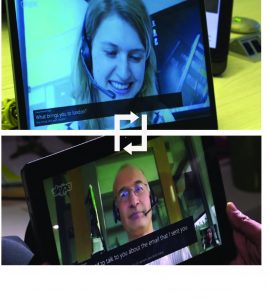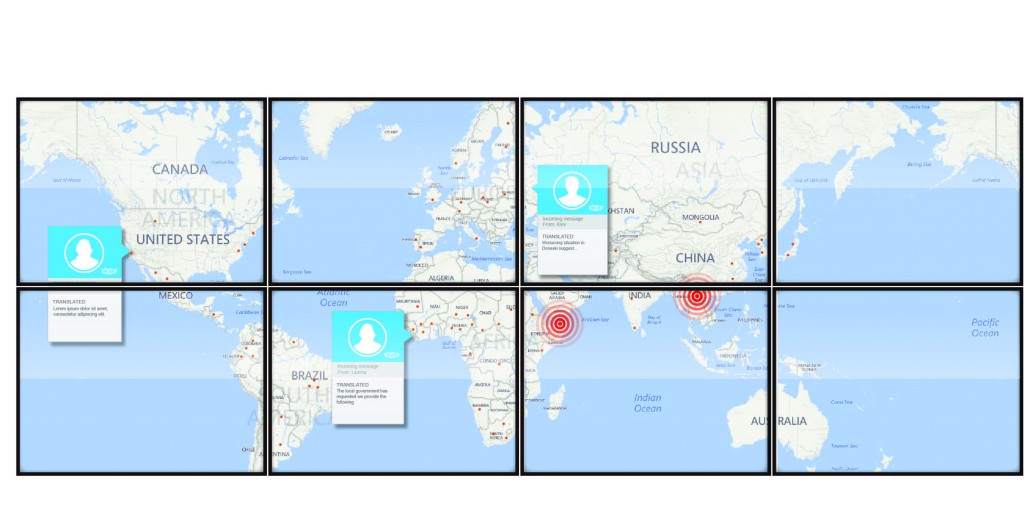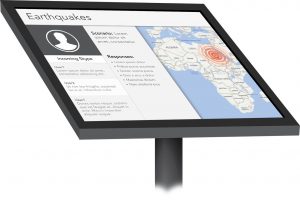Today, I was honored to announce a $1 million in-kind contribution to build a high-tech interactive exhibit at the U.S. Diplomacy Center (USDC)—the first step in a partnership with the Diplomacy Center Foundation (DCF). Opening in 2017 in Washington, DC, the USDC will be a next-generation museum and education center that will showcase the importance of American diplomacy. Our new partnership with DCF is an exciting step for Microsoft’s technological and philanthropic efforts and will help Americans understand U.S. diplomacy in a new and unique way. I thank Ambassador Elizabeth Frawley Bagley, a senior advisor to Secretary of State John Kerry and a Director of the Diplomacy Center Foundation, for working with us to develop this exciting partnership.
[See this PowerPoint presentation on the Microsoft-DCF partnership, including design concepts for the exhibits.]
Microsoft’s cutting-edge technologies will transport museum visitors to the front lines of American diplomacy. As we picture it, the DIPLOMACY IS EVERYWHERE, 24/7 Exhibit will feature the latest Microsoft technology, such as Surface Hub touch screens, Skype Translator, and Bing Maps. The result will be a next-generation museum—where visitors can virtually play the role of diplomat. They’ll travel where diplomats travel, talk with foreign diplomatic counterparts, and make the decisions diplomats make every day around the world.
We picture Microsoft’s technology embedded throughout the museum bringing exhibits to life and even “gamifying” diplomacy.
A marquee part of the museum, as we envision it, will feature Microsoft technology through the digital “Diplomacy Wall.” This wall will immerse museum visitors in real-life, interactive scenarios and the issues diplomats work through every day.
This exhibit will present visitors with a series of scenarios – from peace talks to natural disasters – allowing them to learn through hands-on experience how America’s diplomats engage in the world of international diplomacy. Visitors will be able to learn about and interact with these issues, such as hostage situations, or dealing with the aftermath of a tsunami, just as diplomats do on a daily basis.
In the museum, we see USDC visitors being empowered to:
- explore a career as a diplomat by using Surface Hub technology to make decisions about a global event;
- communicate via Skype Translator to speak with non-English speaking international counterparts in real time; and
- virtually travel with Bing Maps to see the region where the “crisis” is taking place.
I have no doubt that the USDC will quickly become one of the most sought after attractions near the National Mall, and that is why we are so excited about this unique partnership. While Microsoft is well-known for our philanthropic efforts, we traditionally pursue initiatives that will advance education or inspire young people to pursue a career in the STEM fields. Our partnership with the USDC combines these philanthropic pursuits, using both education and technology to inspire young people to pursue a career in diplomacy.
In at least one respect, our work at Microsoft is not so different than the important work being done by the U.S. Department of State. Technology, like diplomacy, is used to connect people separated by distance and help them find common ground. Thanks to the efforts of our men and women in the Foreign Service, leaders and nations across the globe can negotiate and maintain peace and sovereignty.
 You can visit the U.S. Diplomacy Center website at diplomacy.state.gov and the Diplomacy Center Foundation (DCF) web site at DiplomacyCenterFoundation.org. You can also see more information in the linked presentation and FAQs.
You can visit the U.S. Diplomacy Center website at diplomacy.state.gov and the Diplomacy Center Foundation (DCF) web site at DiplomacyCenterFoundation.org. You can also see more information in the linked presentation and FAQs.


